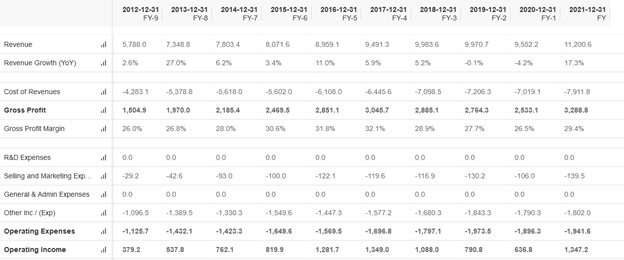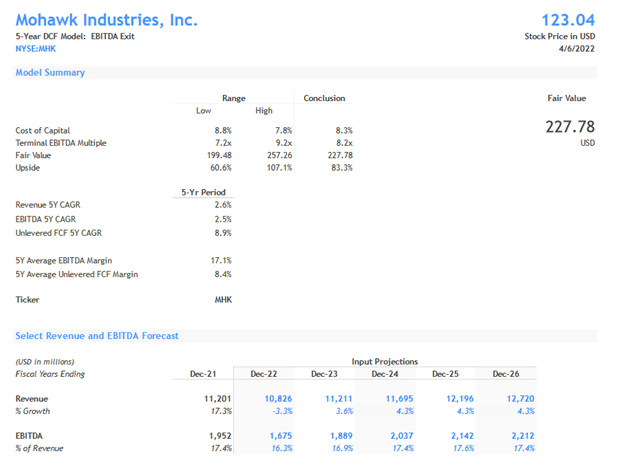-
Mean reversion can be a powerful mental model for analyzing companies.
-
In the current environment, though, finding the true mean is harder than ever.
-
Mohawk Industries (NYSE:MHK) has a cheap valuation, but typifies this challenge.
-
I’ll look at the good, the bad, and what it adds up to for Mohawk stock.
-
For more investing ideas and undervalued stocks, check out InvestingPro+.
An investing theme that has obsessed me since the Covid 19 pandemic started has been how to sort through the periods of compressed change. 2020-mid 2021 was one environment, with the shutdown vs. open up dynamic, digital acceleration, and stimulus-fueled consumer behavior dictating much of the economy, and the stock market's direction. We’re now fully in another environment, as individual markets regress and over-regress from the previous aberrations, and factors like inflation, decreasing stimulus, and geopolitical turmoil and war step into the picture.
I tend to view investing and the world through the principle of mean reversion and that there’s nothing truly new under the sun. But what does mean reversion look like after such a slingshot, bullwhip sort of dynamic? Could inflation break our normal feedback cycles, or could the Russia-Ukraine war do the same? And that’s before even wondering about longer-term questions like demographics, debt, or climate change. Mean reversion may happen, but the new mean may be different.
Last week I mentioned Mohawk Industries as an interesting-looking name according to Investing Pro+. The company is a leading flooring manufacturer – carpet, vinyl, ceramics – and its financial performance has been impressive. At the same time, shares are trading around 52-week lows and have given back all of the company’s pandemic-era gains, despite a housing-driven boom. So Mohawk has attractive fundamentals, but it also typifies both the risks of a snapback effect and the new dynamics that could affect its future fundamentals.
Is it a buy? Let’s break down both sides of it.
The good about Mohawk – Fundamentals and Valuation
Mohawk sells floors or ceramic countertops. Per their 10K, 60% of their revenue is from the U.S. and 40% from the rest of the world, and their segments break down as Global Ceramic (35% of 2021 sales), Flooring North America (37%), and Flooring Rest of the World (28%).

Source: Investing Pro+
Their income statement shows that the company has posted a 7.6% compound annual growth rate (CAGR) on the top line, 15% CAGR for operating income, and 17% CAGR for EPS and Net Income (not seen in this screenshot). This is encouraging as it suggests there is consistent demand for their products and that they have operating leverage, i.e. they make higher profit margins as they sell more.
The balance sheet suggests that this isn’t the result of undue leverage, and that the equity value of the firm has grown nicely – 9.5% CAGR for equity and 10.5% CAGR for tangible equity, and an in-line 10% CAGR for net debt. So the leverage ratios have been pretty consistent over a period of strong growth.
The cash flow statement is a little less exciting – 2021 free cash flow is down 6% from 2016. Part of that is an inventory build (after selling down a lot of inventory in 2020). I can export the cash flow statement and play with it, and if I back out the major working capital issues (Accounts Receivable plus inventories), free cash flow has an 8.25% CAGR since 2016, and nearly 15% since 2012, so the underlying numbers are solid even as the company invests in growth.
For all this – solid growth without taking on undue debt, profitability as the company has scaled, and investment to sustain that growth – the valuations are near bottom. Here’s a simple chart of the company’s trailing P/E ratio over the last decade to illustrate that:

Source: InvestingPro+
So we have a company that had a record year, is growing well, is exposed to a market (housing) that would seem to have tailwinds, and that is trading at low valuations. This is either an exciting opportunity or a major red flag. Which leads us to the bad parts of the Mohawk story.
The bad about Mohawk – War, cost inflation, and housing market slowdown risks
In their Q4 earnings release, Mohawk guided for Q1 adjusted EPS of $2.9-3 a share, which would be a bit lower than last year, and said they expect “our margins to improve (in the second half of 2022) as capacity expands, inflation moderates and pricing aligns.” They also stated “our long-range outlook is for higher sales growth and margin expansion,” and that, “over the next three years, we anticipate higher sales and margins as we implement our product, manufacturing and marketing initiatives.”
This is bullish – the market is clearly pricing in a downturn in Mohawk’s profits, so growing from a record high would be amazing. But, that release came out on February 10th. Which means it only touched on one of the three major issues that have weighed on Mohawk’s stock.
1. Inflation
Inflation is a risk for companies if they can’t offset it with pricing, and when input costs keep going up, it becomes hard for pricing to keep up. For Mohawk, this is mostly a story of natural gas, and mostly a Europe story at that. European natural gas prices are not at 52-week highs, but they are still 43% above where they were in February, when the company called out their European ceramic business would face a $40-45M headwind. It’s hard not to imagine that headwind increasing. And for that matter, US natural gas is also trading at 10-year plus highs; while the dynamics in that market are different from Europe, it’s still a cost pressure for Mohawk.
2. Russia
Russia’s invasion of Ukraine is an obvious catalyst for rising natural gas prices. But Russia as an end market for Mohawk is also not trivial – the country accounted for 4% of Mohawk’s 2021 revenue, or $450M. The company doesn’t break out profitability per market, but that is a non-trivial exposure. JPMorgan (NYSE:JPM) downgraded the company from Overweight to Underweight and called out the company’s outsized exposure to Russia and Europe as a reason to stay away.
3. The Fed and housing
The U.S. housing market has been on fire for nearly the entire pandemic. The Federal Reserve has made noise about accelerating its rate hike and balance sheet tightening plans, with the tone becoming much more hawkish since Mohawk reported its earnings just 6 weeks ago. Logan Mohtashami, a housing analyst for HousingWire, has made the case that the Fed is laser focused on slowing the housing market, a market it has more control over.
Buying new houses, remodeling houses, renovating, spending stimulus cash or bull market cash on making the home better: these are all things Mohawk and other flooring companies benefit from. The sell-side at least is settling on a consensus that housing may hit an 'air pocket', as Jefferies put it. The Fed might succeed at bending inflation, but at the cost of slowing down Mohawk’s key end market.
The Upshot – What’s Left to Consider for Mohawk?
The question whenever we make an investment is what’s already priced in. Earnings are currently expected to be flat in 2022 before rising again in 2023, but we can expect to see a bevy of adjustments after the company reports its Q1 earnings on April 28th – they have not to date released a press release about the war or any direct impact on the business.
I’m going to use the 5-year DCF EBITDA exit model from Investing Pro+ to try to parse out the longer-term impact of all of this. I start with the Investing Pro+ baseline of moderate growth over the next 5 years (4.3% CAGR), in-line EBITDA growth, and then I adjust for the following realities:
-
I’m going to write Russia revenue down to 0 from March on. Pro-rating $450M to the first two months of the year is $75M. I’m going to write EBITDA down to 0 for the full year, assuming added costs due to whatever changes they had to make. Using last year’s global margin of 17%, that adds up to a $77M EBITDA hit.
-
I’m going to build in a $200M EBITDA headwind for inflation-related costs that can’t be passed on quickly enough in 2022; the company said $40-45M for Q1, if we increase that by 20% to account for the late spike in gas prices we get to $50-$54M, and we can assume that some of it will abate by the end of the year due to either price hikes or gas prices dropping (I’m banking more on the price hikes to be fair)
-
I’m going to just use last year’s revenue number for 2022, i.e. no growth for 2022 as a baseline before the Russia adjustment, to account for a possible U.S. or Europe top-line slowdown.

Source: InvestingPro+
That’s 85% upside at Wednesday’s closing price. The above scenario isn’t super bullish, but it also isn’t a bear market, housing-grinds-to-a-halt scenario. It’s a ‘we missed our growth expectations in 2022 and then get back on track’ scenario.
What does a bear market look like? Mohawk managed to produce positive free cash flow throughout the great financial crisis of 2008, and housing took a long time to recover from that market. I’m skeptical the current environment will be worse for Mohawk, but even if we cut EBITDA in half for the foreseeable future, at $1B in EBITDA (lower than their 2014 level) vs. the current enterprise value of $9.7B, a steady-state multiple of 9.7x is not awful.
A few last notes:
-
Mohawk is buying back shares aggressively – they spent $900M buying back 6% of the outstanding shares in 2021, and then bought another $37M in the first 6 weeks of 2022, before announcing a new $500M program. The average price per share is, umm, much higher than the current share price ($187/share), but they accelerated through the end of 2021 so at least they are price sensitive.
-
Their long-time COO Christopher Wellborn purchased 10,000 worth of shares for $1.36M on February 24th, right after the war started. This was the first direct buy I could find that he made in the last 5+ years, and is a not trivial bet (it accounts for 6.6% of his total position).
-
It would be worth comparing Mohawk to peers. The housing-related sector of the stock market has sold off, so the bargain (or risk) opportunity could be found in other companies which might not have as concentrated a Europe or Russia-related risk. Here’s what Pro+’s basic comparison shows:

Source: InvestingPro+
MHK is the laggard valuation wise, and somewhat in the middle of the pack revenue growth-wise. But there may be other comparables to add or other interesting opportunities, like a FBHS.
Conclusions
Mohawk is cheap for a few good reasons. I think there’s enough known and unknown about the big three factors – Russia, inflation, and the Fed/housing market – to be cautious about shares, both in the event of further market level volatility and in terms of the company itself.
At the same time, Mohawk’s track record of profitable growth, of holding up well in extreme crises, and of returning capital to shareholders, it all has my attention, and the valuation is fairly attractive. I’d like to do more research on the industry and broader sector to see if there are better opportunities, and to get a sense of how bad the current sentiment and environment might be.
But, if (fingers crossed) inflation and Russia and even an onsetting recession are blips that pass, and we look back on all this the way we looked back on all the market scares of the past, then this could be a nice opportunity to get in on a ground floor valuation of a solid industry leader.

